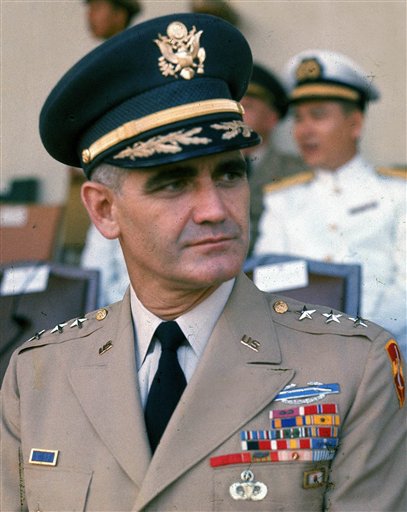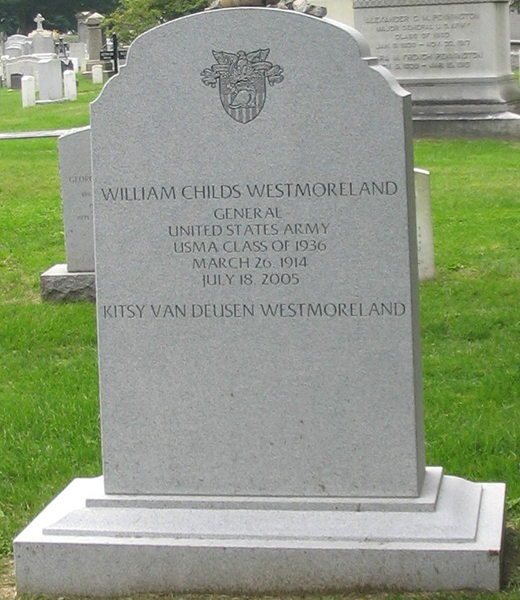Westmoreland, William Childs
- Date of birth:
- March 26th, 1914 (Saxon/South Carolina, United States)
- Date of death:
- July 18th, 2005 (Charleston/South Carolina, United States)
- Buried on:
- United States Military Academy Post Cemetery
Plot: 18. Row: 66. - Service number:
- 0-20223
- Nationality:
- American
Biography
Do you have more information about this person? Inform us!
- Period:
- Second World War (1939-1945)
- Rank:
- Lieutenant Colonel
- Unit:
- 34th Field Artillery Regiment, 9th Infantry Division "Old Reliables", U.S. Army
- Awarded on:
- May 13th, 1943
- Period:
- Vietnam War (1955-1975)
- Rank:
- General
- Unit:
- Military Assistance Command Vietnam, U.S. Army
- Awarded on:
- December 1st, 1966
Department of the Army, General Orders No. 45
- Period:
- Vietnam War (1955-1975)
- Rank:
- General
- Unit:
- Military Assistance Command Vietnam, U.S. Army
- Awarded on:
- April 8th, 1968
"The President of the United States of America, authorized by Act of Congress July 9, 1918, takes pleasure in presenting a Bronze Oak Leaf Cluster in lieu of a Second Award of the Army Distinguished Service Medal to General William Childs Westmoreland (ASN: 0-20223), United States Army, for exceptionally meritorious and distinguished services to the Government of the United States, in a duty of great responsibility as Commander, Military Assistance Command, Vietnam, during the period from January 1966 to December 1967."
Second DSM received as Bronze Oak Leaf Cluster
Second DSM received as Bronze Oak Leaf Cluster
- Period:
- Vietnam War (1955-1975)
- Rank:
- General
- Unit:
- Military Assistance Command Vietnam, U.S. Army
- Awarded on:
- August 22nd, 1968
"The President of the United States of America, authorized by Act of Congress July 9, 1918, takes pleasure in presenting a Second Bronze Oak Leaf Cluster in lieu of a Third Award of the Army Distinguished Service Medal to General William Childs Westmoreland (ASN: 0-20223), United States Army, for exceptionally meritorious and distinguished services to the Government of the United States, in a duty of great responsibility as Commander, Military Assistance Command, Vietnam, during the period from December 1967 through July 1968."
Department of the Army, General Orders No. 44
--
Third DSM received as Bronze Oak Leaf Cluster
Department of the Army, General Orders No. 44
--
Third DSM received as Bronze Oak Leaf Cluster
- Period:
- Vietnam War (1955-1975)
- Rank:
- General
- Unit:
- Chief of staff of the Army (CSA), U.S. Department of the Army, U.S. Department of Defense, U.S. Government
- Awarded on:
- February 18th, 1972
- Period:
- Vietnam War (1955-1975)
- Rank:
- General
- Unit:
- Chief of staff of the Army (CSA), U.S. Department of the Army, U.S. Department of Defense, U.S. Government
- Awarded on:
- July 6th, 1972
Department of the Army, General Orders No. 30
--
Fourth DSM received as Bronze Oak Leaf Cluster
- Period:
- Korean War (1950-1953)
- Rank:
- Brigadier General
- Unit:
- 187th Regimental Combat Team "Rakkasans", 11th Airborne Division "Angels", U.S. Army
Third LoM received as Bronze Oak Leaf Cluster
- Period:
- Second World War (1939-1945)
- Period:
- Second World War (1939-1945)
- Period:
- Second World War (1939-1945)
- Period:
- Second World War (1939-1945)
- Period:
- Second World War (1939-1945)




















